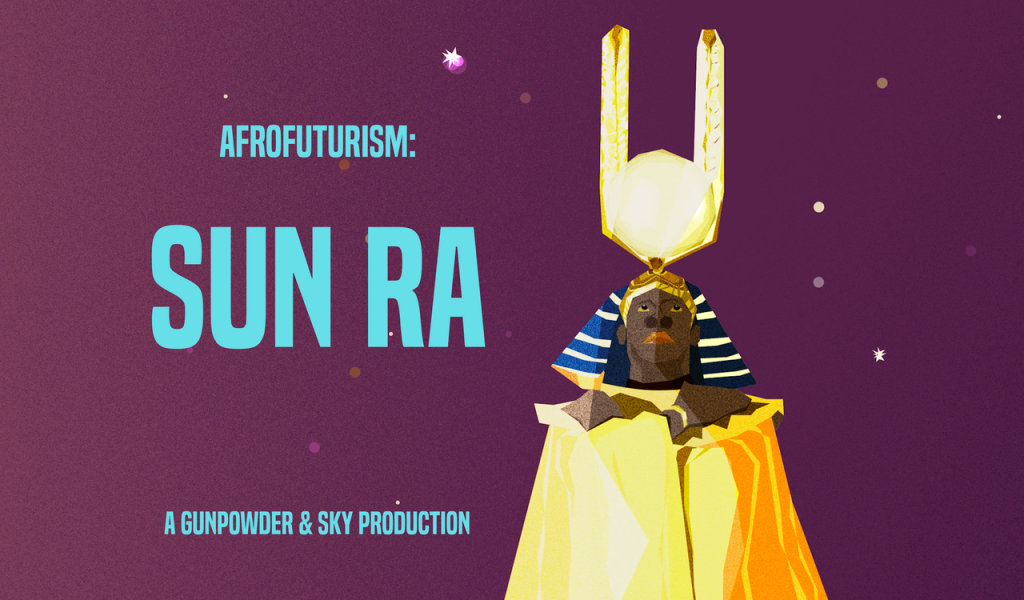Meet the Creators Behind DUST’s New Original Series AFROFUTURISM

We sat down with Sama’an Ashrawi and Steven Jackson, the two DUST Producers behind our new original series Afrofuturism, to find out the inside scoop on the inception and creation of the series. If you haven’t, be sure to take a look at the first episode Afrofuturism: Sun Ra.
First, can you give us a little background on Afrofuturism?
Steven: Afrofuturism is a cultural movement combining various elements of music, science fiction, fantasy, and Afrocentrism, which addresses a lot of concerns and themes of the black experience through a sci-fi and technoculture lens.
Sama’an: I think it’s important to note that it means different things to different people, but, broadly, we can think about it as visions of future, or alternate realities, that are rooted in Black culture and the Black experience and influenced by technology and art.
Why was DUST interested in exploring this topic?
Steven: Our interest stems from exploring a world that, for many years, has been unknown to a lot of people. Elements of Afrofuturism have had tremendous crossover into mainstream pop culture with artists like Missy Elliot, Janelle Monáe, and George Clinton.
Sama’an: With DUST, our goal is to bring our viewers visions of the future that you don’t see on other sci-fi channels; exploring Afrofuturism fits right in with that goal.
How do you see Afrofuturism fitting into science fiction as a whole?
Steven: These aren’t new concepts or stories by any means, they’ve just been hidden in plain sight.
Sama’an: We want to be clear that folks should not think of Afrofuturism as a subgenre. It’s its own thing really and it’s not dependent on present-day science-fiction to survive.
Why do you think telling these stories is important and what do you hope your audience will take away from watching the series?
Steven: I think it’s not only important but refreshing to see more science fiction storytelling from the black perspective because the African diaspora is so vast. I hope the audience learns that, just because Afrofuturism came into fruition through the black struggle, it doesn’t mean that this concept is just for black people. I think as this series unfolds people will see that.
Sama’an: Until mainstream science-fiction is made to be more inclusive, it will continue to be not only important, but also imperative, that these stories be told. Look at how Hidden Figures is doing at the box office. Could that be a clue that audiences want to see black people included in stories about outer space? As we put this project together, we spoke with so many people who had no idea this world existed, and that’s when we knew we were doing something special.
Was there anything you learned that surprised you while doing research on the topic?
Steven: For me, I learned a lot about Sun Ra and how intriguing this man was. He was truly ahead of his time, as it seems many people in the world of Afrofuturism are.
Sama’an: Isn’t it crazy that it took nearly 30 years from Star Trek’s debut for the U.S. to send a black woman into space?
Sama’an, you co-wrote this series with Karas Lamb. Is there something special about Karas’ perspective you feel added to the series?
Sama’an: Karas is a very talented, Philly-based writer who just finished the THREAD Program at Yale. I’ve known her for years and she was the first person I reached out to when I began putting this thing together and I’m so glad she got down with us. We needed her voice and perspective.
Steven, can you tell us a little about the Art Director, Monica Ahanonu, and what drew you to work with her. What unique flare does she add to this first episode on Sun Ra?
Steven: I found Monica’s art online and immediately fell in love. The way she blends colors and shapes together to create these insane images caught my attention for sure.
Prominent British rapper Little Simz does the Voice Overs for the series. How did she feel about working on this project?
Sama’an: It’s an honour with an extra “u” to have Simz on this project. Simz was an obvious choice for me because she runs with a London crew called Space Age, so her head was already in the right place. I met Simz and her manager, Eddie, when I first moved to Los Angeles and was blown away by her energy. Her most recent album, Stillness in Wonderland, is like a movie in and of itself, so if you are intrigued by Afrofuturism and want to delve into contemporary black artists who are imagining themselves in space or alternate realities, Simz is the best place to start.
What other topics do we have to look forward to later in this series?
Steven: Space is the place!
Sama’an: We’re going to tell the stories of pioneers of Afrofuturism thinking and storytelling in a way that spans the decades of modern pop culture. I won’t give away who else is going to be part of it, but it’s really really cool. And we wouldn’t do it if it wasn’t cool, okay?

